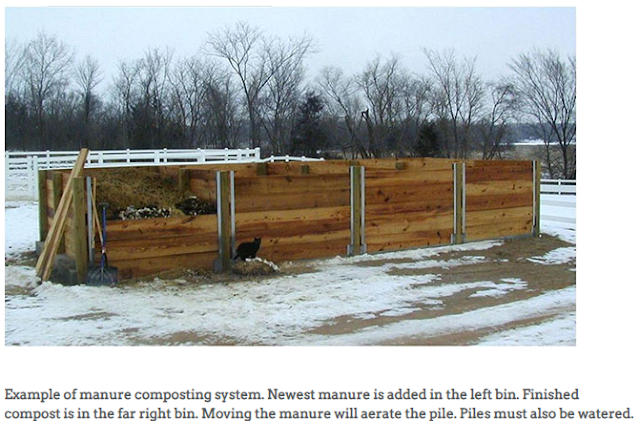Published by Kara Harders, Small Acreage Management Specialist
Composting is a natural process we can utilize to help break
down and recycle materials which would have otherwise been considered trash or
waste. Materials including food scraps, garden byproducts, and other organic
“trash” can become the magical soil amendment we know as compost!
Because composting is a natural process, it can be induced
by following some basic rules and creating ideal conditions for the process to
happen. While people may think they are the ones composting it is really bacteria,
fungi, molds, and worms doing all the heavy lifting. When we compost it is
important to keep these organisms happy and healthy so they can do what they do
best, turn trash into soil gold! Luckily, they only need a few things to do
what they do best.
Food! (Nitrogen and carbon rich)
These composting critters work best when given about a 30:1
Carbon to Nitrogen ratio. The carbon source could be dead plants, bedding,
grass clipping, leaves or even shredded office paper. The nitrogen source could
be fresh grass cuttings, food scraps or animal manure.
Moisture
Like all living things, water is essential to the life in
your compost heap. Most of the organisms breaking down materials in your
compost pile live in the film of moisture around the “ingredients” in the pile.
Too little moisture and they will die or become dormant and too much moisture
and they will drown (and the pile will smell BAD). Aim for a pile that feels
damp, like a wrung-out sponge. If the pile gets too dry spray it lightly with a
garden hose and try to keep it covered with a tarp in a shady area to retain
moisture and to keep out heavy rains.
Form
Compost needs to be grouped to maintain moisture and heat;
therefore, the structure of your compost needs to be in a heap of sorts. This
may seem obvious, but there are a few critical details.
Consider where you are putting your pile, avoid spots in
direct sunlight for much of the day as this can dry out your pile. You should
also avoid areas where water collects or drains. Compost piles are rich in
nutrients that can be harmful to water ways and contribute to nutrient
pollution. Think about keeping water from running through the pile when it
rains or snow melts.
An ideal size is about on cubic yard, a pile this size can
be built over time (cool composting) or all at once (hot composting), a benefit
to doing hot composting is the sterilization of some weed seeds. Large heaps
made all at once with the correct balance of materials and moisture can break
down materials so fast the internal temperatures of these piles can reach 160ºF! Smaller piles wont
hold heat as well and can dry out quickly if done outside of a container, but
they will be easier to turn. Speaking of turning…
Aeration
All those composting organisms you are after also need to
breath, in addition to design, to get them oxygen you will need to “turn” the
pile.
Ideally, your compost pile will sit on some coarse materials
to help allow air travel in from the base. When setting up the pile make an
effort to use materials which create air pockets, such as stems, stalks, wood
chips and other rigid materials. These will help to draw air up and out of the
pile.
Use a composting thermometer to gauge the inside
temperature. When it reaches 140ºF,
give it a turn and water as needed. Turning the compost will also help get air
to the organisms doing the dirty work. You can turn the compost as often as the
temperature reaches 140ºF.
It is recommended to let the pile go through three heating cycles to help
sterilize weed seeds.
Particle size
While it is not always possible or realistic to select items
for your compost pile by size it can make it more efficient. Because the
organisms breaking down material work on the outer surface of the composted materials,
they work much quicker when the surface area is large in relation to the
particle size’s mass, in other words, small pieces break down much faster. You
can mulch logs/branches, cut stalks to less than 5”, mow leaves with the lawn
mower, and break up manure clumps.



No comments:
Post a Comment